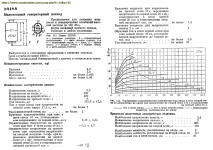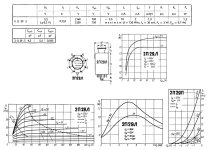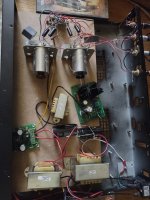Thanks! Yeah I backed off a little to 14ma/120Vak. Things seem a little happier now🙂At 125-130Vak the max. anode current (-5V bias) is about 16..17mA ... and no headroom to dissipation limit.
12mA is better anode current.
View attachment 1154472
I agree with Andy. This tube is very easy to set up. Very little microphonics, low distortion, sounds wonderful, well matched within the lot of 8 that I bought, and cheap.
In all fairness, these tubes are 40 years younger than the 1920’s-30’s classic DHT’s so looks like manufacturing caught up with the technology.
Because of my positive experience with the 2P29L, I picked up one of these that uses the similar 2J27L, which someone mentioned earlier in the thread. Mu is ~16 vs ~8 for the 2P29L.
https://www.audiokarma.org/forums/i...e6-preamp-uses-directly-heated-tubes.1009865/
Although I had no issues, many users have reported problems with the Chinese tubes. Using the Russian version seems to eliminate them.
I don't think I've ever seen a mass produced preamp that uses DHTs, so I had to try one. I've been pleasantly surprised.
https://www.audiokarma.org/forums/i...e6-preamp-uses-directly-heated-tubes.1009865/
Although I had no issues, many users have reported problems with the Chinese tubes. Using the Russian version seems to eliminate them.
I don't think I've ever seen a mass produced preamp that uses DHTs, so I had to try one. I've been pleasantly surprised.
@andyjevans, do you happen to know the gain and output impedance of the preamp circuti in post #115 ?
I have a DAC as audio source and solid state amplifier, so I was curious if I can put this preamp in between.
Thanks.
I have a DAC as audio source and solid state amplifier, so I was curious if I can put this preamp in between.
Thanks.
You can usually look up all the data on Franks, but can't see it there so I'm attaching what I have.
Gain is x9 approx and Ra is 3K. No problem with your DAC into it. You would want the input impedance of your amp to be 30K or higher. If it's lower than that you could use a 4P1L with Ra of 2.2K approx , which should be OK into 20K. If the input impedance of your amp is below 20K you would need a step-down transformer on the output or a different tube. The 6B4G can be used in filament bias but that's completely overkill for what you want so I just mention that out of completeness, though it sounds damn good. But if your amp has an input impedance of below 20K then you'd probably run your DAC straight into it or via a passive attenuator.
Gain is x9 approx and Ra is 3K. No problem with your DAC into it. You would want the input impedance of your amp to be 30K or higher. If it's lower than that you could use a 4P1L with Ra of 2.2K approx , which should be OK into 20K. If the input impedance of your amp is below 20K you would need a step-down transformer on the output or a different tube. The 6B4G can be used in filament bias but that's completely overkill for what you want so I just mention that out of completeness, though it sounds damn good. But if your amp has an input impedance of below 20K then you'd probably run your DAC straight into it or via a passive attenuator.
Attachments
I finally finished this project. Started off as a 71a but too much microphony. Moved to 2p29L which really worked out great. Used SMPS and DCDC converters for B+ and filaments. Turned out it was indeed a major pain, but in the end gave good results. Ended up using some cinemag input transformers because I couldn't get rid of some noise. When using certain USB dacs, noise was horrendeous. I really couldn't fix it no matter what grounding scheme. Input transformers cleared up all noise, and I can't believe how quiet this amp is. I'm using 1/4" jacks for balanced in. Recycled a stromberg-carlson amp chassis and had a custom lid laser cut and bent for me.
2P29L goes into a 100K attenuator. I ended up throwing a B1 Rev 2 buffer on the output of that, into a Neurochrome Modulus.
Anyway, in the end it was a lot of work but really sounds so fantastic, I'm thrilled. I realize most of the heavy lifting was done by Tom's Neurochrome modules, but all in all it was a really fun project. Maybe the tubes and input transformers added some magic I'm not really sure🙂
2P29L goes into a 100K attenuator. I ended up throwing a B1 Rev 2 buffer on the output of that, into a Neurochrome Modulus.
Anyway, in the end it was a lot of work but really sounds so fantastic, I'm thrilled. I realize most of the heavy lifting was done by Tom's Neurochrome modules, but all in all it was a really fun project. Maybe the tubes and input transformers added some magic I'm not really sure🙂
Attachments
-
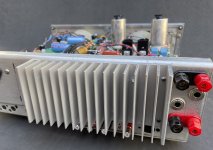 back-angle-sm.jpg505.6 KB · Views: 212
back-angle-sm.jpg505.6 KB · Views: 212 -
 back-sm.jpg364.1 KB · Views: 202
back-sm.jpg364.1 KB · Views: 202 -
 front-daylight2-sm.jpg356.6 KB · Views: 200
front-daylight2-sm.jpg356.6 KB · Views: 200 -
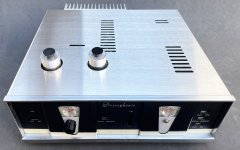 front-top-angle-sm.jpg443 KB · Views: 220
front-top-angle-sm.jpg443 KB · Views: 220 -
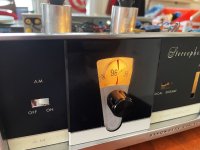 lamp detail left-sm.jpg587.3 KB · Views: 221
lamp detail left-sm.jpg587.3 KB · Views: 221 -
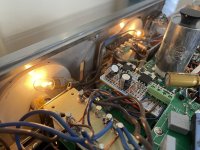 lamp-inside-sm.jpg672.9 KB · Views: 232
lamp-inside-sm.jpg672.9 KB · Views: 232 -
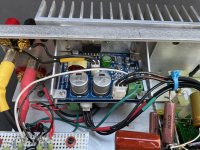 neurochrome-sm.jpg752.6 KB · Views: 245
neurochrome-sm.jpg752.6 KB · Views: 245 -
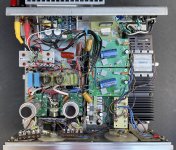 top-open-sm.jpg1.1 MB · Views: 232
top-open-sm.jpg1.1 MB · Views: 232 -
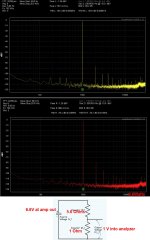 measurements.jpg308.3 KB · Views: 263
measurements.jpg308.3 KB · Views: 263
Last edited:
well done on an unusual build! Love how you did the front panel - kudos!
As it happens I'm sitting hear listening to my own 2P29L into an LM3886, but not a neurochrome one. I started out my build with the 4P1L but the mircophony was a killer on the valves I had here. So I switched to 2P29L and I've been enjoying it very much. Mine is more of a formula than yours - Rods filament regs, Ale's gyrators on the anodes, r-core transformers etc.
Enjoy!
As it happens I'm sitting hear listening to my own 2P29L into an LM3886, but not a neurochrome one. I started out my build with the 4P1L but the mircophony was a killer on the valves I had here. So I switched to 2P29L and I've been enjoying it very much. Mine is more of a formula than yours - Rods filament regs, Ale's gyrators on the anodes, r-core transformers etc.
Enjoy!
You, know, I thought I had some photos of the build, but couldn't find them when I went to look.If I have it open again, I'll take some. Its fairly conventional build though, I think the only unusual thing is I used a maida reg in front of the gyrator, just because I had one built and it saved a bit of space compared to CLCRC type filter. I used those 10W Russian resistors for filament bias. After that, its a relay based 6 input selector, EIZZ pot and the circuit is as per Bartola's website.
Very happy with the sound. I think its equivalent to my 01a, but a different sound which is a nice complement to it.
Very happy with the sound. I think its equivalent to my 01a, but a different sound which is a nice complement to it.
I’m also quite happy with the sound. The only thing I can compare it with is a Salas 6V6 preamp into a hypex NCMP power amp I put together.
That was the inspiration for this one. It was a slightly clumsy 2 box solution. I wanted the same idea but all in one box and DHT.
While the Salas hypex combo is quite nice, this one is way crisper but still very natural. Bass is also more articulate here.
Edit- I forgot to mention that I added 5-6 dB NFB which is always controversial, but it lowered the noise, got the gain where I wanted and overall sounds terrific
That was the inspiration for this one. It was a slightly clumsy 2 box solution. I wanted the same idea but all in one box and DHT.
While the Salas hypex combo is quite nice, this one is way crisper but still very natural. Bass is also more articulate here.
Edit- I forgot to mention that I added 5-6 dB NFB which is always controversial, but it lowered the noise, got the gain where I wanted and overall sounds terrific
Last edited:
@andyjevans, I'm trying your circuit from post #115. B+ is fed from a LR8N regulator and set at 175V. Filaments are fed from a LM317 regulator set at 11.1V. With 76R to ground I'm getting 9V at the other filament pin. But I've only got 114V at the plates. 175V seems low compared to some of the other schematics posted here. Is that meant to be 275V?
Hello - yes, should be 275V of course. Slip up there. The voltages should come right then.
I'd strongly recommend Rod Coleman regs, V9 from Lyrima. It will sound much better than LM317.
I'd strongly recommend Rod Coleman regs, V9 from Lyrima. It will sound much better than LM317.
I got it working but it took a little troubleshooting. On Sunday, I increased the B+ to 275V and got 145V at the anodes. I wasn't sure it would have enough gain to drive my Mofo monoblocks(class A voltage followers) or if I would even like the sound. So this was thrown together, trying to use what I had on hand as much as possible. Hence, the mess you see pictured below. Well, after hooking it up, I was greeted with quite a bit of distortion. Initially, I thought it was a bad pairing so I put it in front of a class AB commercial amp to see how that fared. In front of the AB amp, I got lots of white noise joined by a low squeal that got increasingly loud until I turned everything off. After a little research, it seemed the problem was likely oscillation due to RF interference. So I played with the grounding of pins 2,6 and the center pin. But could not get rid of that squeal. Using an MDF base in the enclosure made it easy to mock things up temporarily but I could not safely attach the cover, so up to this point it wasn't properly shielded. Well, that turned out to be the problem. I was able to safely "drape" the cover over the enclosure and the squeal finally disappeared. I want to spend a little more time with it before I decide whether or not to go through with a permanent build. If I do, I will definitely upgrade to better regulators
Attachments
Using common "ground bus" of all inputs and outputs isn't the best solution.
Use individual "cold" wire for all inputs/outputs tightly twisted with own "hot" wire.
Sample (black/white):
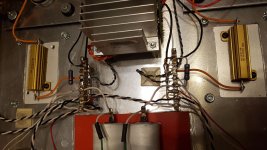
Use grid stoppers (R2 in this schematic), B+ filter capacitors (C2) for each channels, and local ground points (R1-R3-R4 common point) for each stages.
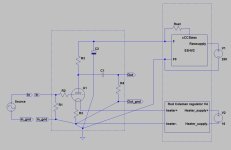
Use individual "cold" wire for all inputs/outputs tightly twisted with own "hot" wire.
Sample (black/white):

Use grid stoppers (R2 in this schematic), B+ filter capacitors (C2) for each channels, and local ground points (R1-R3-R4 common point) for each stages.

Last edited:
I usually run twisted pairs for signal wires but resorted to a "ground bus" here, for simplicity.
Take a wire one end grounded to chassis
With the other end of the wire, strip it and rubber band it to the tube casing.
These tubes need you be shielded and grounded
With the other end of the wire, strip it and rubber band it to the tube casing.
These tubes need you be shielded and grounded
There are nice shielded sockets for these valves on ebay - good quality contacts and not expensive. Something like these:
https://www.ebay.ie/itm/28481338637...uid=hzg66PZKT9W&widget_ver=artemis&media=COPY
I use a single ground on mine (relay input board) with no ill effects, but short runs, and extreme care running grounds.
https://www.ebay.ie/itm/28481338637...uid=hzg66PZKT9W&widget_ver=artemis&media=COPY
I use a single ground on mine (relay input board) with no ill effects, but short runs, and extreme care running grounds.
Those look like very nice sockets.
To test though, he can just run a wire from chassis and temporarily attach to the metal tube body. Interested to hear if it solves the problem.
To test though, he can just run a wire from chassis and temporarily attach to the metal tube body. Interested to hear if it solves the problem.
I posed the question in the 4P1L thread but it seems this one is getting more attention...
If I were to do filament bias for 2P or 4P and do hybrid of SIC diodes for first few volts of bias and then place a 3-4ohm resistor at bottom of the string, is that last resistor reflected through the diodes to the anode?
In other words do the diodes gate isolate any extra R from last diode cathode to ground? There is talk of quality of resistor affecting sound, so if it is isolated by diodes I could move it to first position right off the filament to get that possible change?
If I were to do filament bias for 2P or 4P and do hybrid of SIC diodes for first few volts of bias and then place a 3-4ohm resistor at bottom of the string, is that last resistor reflected through the diodes to the anode?
In other words do the diodes gate isolate any extra R from last diode cathode to ground? There is talk of quality of resistor affecting sound, so if it is isolated by diodes I could move it to first position right off the filament to get that possible change?
Interesting . . . I had no issues with noise when I breadboarded the circuit I posted at the beginning of the thread. This was true when using the tubes in stock form (enclosed in their aluminum shield) and also after I removed them from their shielded enclosures. Although not shown on the schematic I posted, I did have Pins 2 and 6, which are internal shields, grounded.I have the tube casings grounded through the center pin on the socket. My problem was that I didn't have the lid on the enclosure.
Perhaps you are located in an area with a lot of RF?
I'm always amazed that my totally exposed breadboard setups with clip leads running everywhere are always very quiet, although I do use grid stoppers "just in case". In fact, both of my most recent builds are actually not shielded in any way. They were built in a wooden "chassis" with no metal at all.
On a side note, my little $60 Nobsound E6 preamp that uses the similar 2J27L without their aluminum shields doesn't seem to pick up any external noise either. Some owners have had issues with the stock Chinese tubes being microphonic but using the Russian version seems to solve the issue. I still haven't tried using the 2P29L in mine since it uses twice as much filament current and I don't want to damage it. The 2J27L has 2x the mu of the 2P29L and uses half as much filament current. I recently ordered another unit to experiment with since some sellers now have them on sale for as little as $50 shipped.
https://www.audiokarma.org/forums/i...e6-preamp-uses-directly-heated-tubes.1009865/
- Home
- Amplifiers
- Tubes / Valves
- 2P29L Preamp
